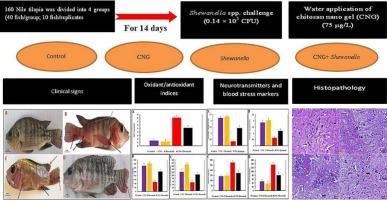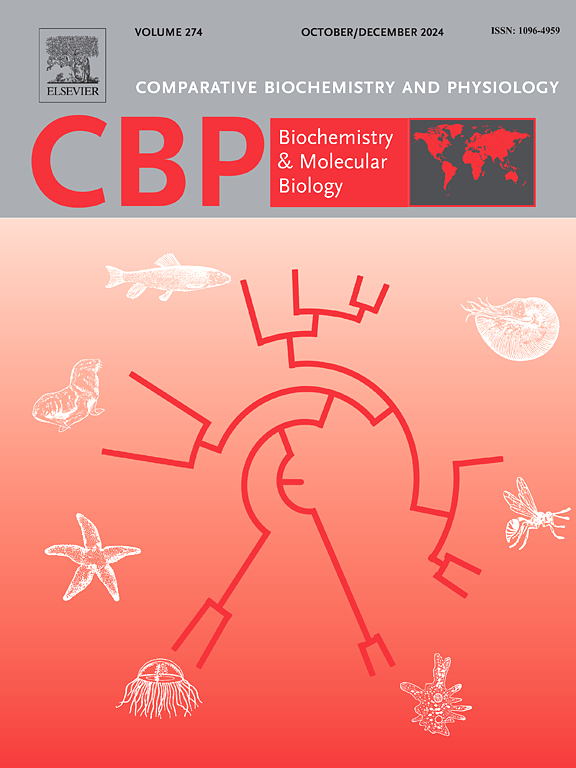Chitosan nanogel mitigates Shewanella-induced oxidative stress, brain neurotransmitter imbalance, biochemical, hepatic, and renal dysfunction, and histopathological changes in Nile tilapia
IF 1.8
3区 生物学
Q4 BIOCHEMISTRY & MOLECULAR BIOLOGY
Comparative Biochemistry and Physiology B-Biochemistry & Molecular Biology
Pub Date : 2025-08-29
DOI:10.1016/j.cbpb.2025.111151
引用次数: 0
Abstract
This study investigated the potential for chitosan nanogel (CNG) to mitigate adverse consequences of infection by Shewanella spp. in the Nile tilapia, Oreochromis niloticus. A total of 160 fish (average weight = 27.55 ± 1.50 g) were allocated to four treatments, each with four replicates, for 14 days. Fish in the control and CNG only groups were intraperitoneally injected with 0.2 mL of sterile saline and placed in water treated with 0 or 75 μg/L, respectively, of CNG. Fish in the Shewanella and CNG + Shewanella groups were injected with 0.2 mL of Shewanella spp. (0.14 × 105 colony forming units) and placed in water treated with 0 or 75 μg/L, respectively, of CNG. Infection by Shewanella induced hemorrhages on the skin and base of the fins, fin rot, and scale loss. Shewanella infection decreased the activity of glutathione peroxidase and catalase, with increased malondialdehyde concentration. Shewanella decreased the brain neurotransmitters (dopamine and serotonin), total protein, and globulin levels, while it increased serum glucose and cortisol. The hepatic and renal dysfunction indicators alanine aminotransferase, aspartate aminotransferase, and creatinine were significantly increased by Shewanella infection. Histopathological changes were produced in the liver, kidney, gills, and brain of Shewanella-infected fish. Notably, Shewanella-infected fish in CNG-treated water had reduced abnormal signs, stress markers, and hepatic and renal dysfunction indicators. CNG water application elevated the brain levels of neurotransmitters and protein and improved the tissue histology. Overall, CNG as a water application is useful for mitigating the adverse effects of Shewanella spp. in Nile tilapia.

壳聚糖纳米凝胶可减轻尼罗罗非鱼shewanilla诱导的氧化应激、脑神经递质失衡、生化、肝肾功能障碍和组织病理学变化
本研究探讨了壳聚糖纳米凝胶(CNG)在尼罗罗非鱼(Oreochromis niloticus)体内减轻希瓦氏菌感染不良后果的潜力。试验选用平均体重为27.55±1.50 g的160尾鱼,分为4个处理,每个处理4个重复,试验期14 d。对照组和纯CNG组分别腹腔注射无菌生理盐水0.2 mL,置于CNG浓度为0或75 μg/L的水中。Shewanella组和CNG + Shewanella组分别注射0.2 mL Shewanella spp. (0.14 × 105集落形成单位),置于CNG浓度为0或75 μg/L的水中。被希瓦氏菌感染后,皮肤和鱼鳍底部出血,鱼鳍腐烂,鱼鳞脱落。随着丙二醛浓度的升高,希瓦氏菌感染降低了谷胱甘肽过氧化物酶和过氧化氢酶的活性。希瓦氏菌降低了大脑神经递质(多巴胺和血清素)、总蛋白和球蛋白水平,同时增加了血清葡萄糖和皮质醇。感染希瓦氏菌后,肝肾功能指标丙氨酸转氨酶、天冬氨酸转氨酶、肌酐显著升高。感染雪瓦氏菌的鱼的肝脏、肾脏、鳃和大脑均发生组织病理学改变。值得注意的是,在经过天然气处理的水中,感染了雪瓦氏菌的鱼的异常体征、应激标志物以及肝肾功能障碍指标都有所减少。CNG水提高了脑内神经递质和蛋白质水平,改善了脑组织组织学。总的来说,天然气作为一种水应用是有用的,以减轻希瓦氏菌对尼罗罗非鱼的不利影响。
本文章由计算机程序翻译,如有差异,请以英文原文为准。
求助全文
约1分钟内获得全文
求助全文
来源期刊
CiteScore
4.60
自引率
4.50%
发文量
77
审稿时长
22 days
期刊介绍:
Comparative Biochemistry & Physiology (CBP) publishes papers in comparative, environmental and evolutionary physiology.
Part B: Biochemical and Molecular Biology (CBPB), focuses on biochemical physiology, primarily bioenergetics/energy metabolism, cell biology, cellular stress responses, enzymology, intermediary metabolism, macromolecular structure and function, gene regulation, evolutionary genetics. Most studies focus on biochemical or molecular analyses that have clear ramifications for physiological processes.

 求助内容:
求助内容: 应助结果提醒方式:
应助结果提醒方式:


